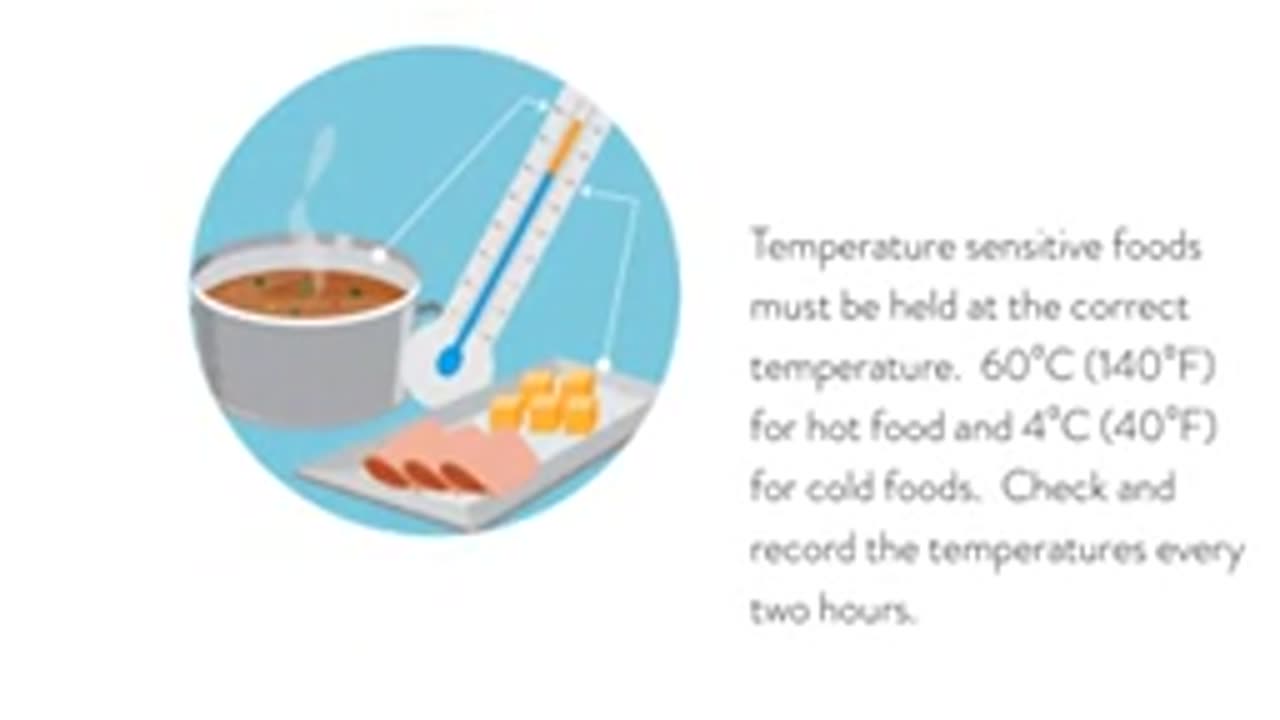Premium Only Content

Your Essential Guide to Serving Food Safely - Buffet and Take Out
### **Your Essential Guide to Serving Food Safely - Buffet and Take-Out**
Serving food safely, whether for a buffet or take-out, is crucial to ensure that food remains safe to eat, delicious, and free from contamination. Both buffets and take-out have unique challenges, and understanding how to handle, serve, and transport food properly can prevent foodborne illnesses and enhance the customer experience. Here’s a comprehensive guide to serving food safely in these contexts:
---
### **1. Maintain Proper Temperature Control**
- **Why**: Temperature is one of the most critical factors in food safety. Foods that are served at improper temperatures can promote bacterial growth, leading to foodborne illnesses.
- **How**:
- **Buffet**: Keep hot foods at **60°C (140°F)** or above and cold foods at **5°C (41°F)** or below. Use chafing dishes, food warmers, or heat lamps to keep hot foods warm. Ensure cold foods are served on ice or refrigerated containers.
- **Take-Out**: Foods should be kept at safe temperatures during transport. Use insulated containers or bags for hot and cold foods. Hot foods should be kept at temperatures above **60°C (140°F)**, while cold foods should remain at or below **5°C (41°F)**.
- **Thermometers**: Use food thermometers to check that foods are within safe temperature ranges before serving or packaging.
---
### **2. Prevent Cross-Contamination**
- **Why**: Cross-contamination is a major cause of foodborne illnesses, as harmful bacteria can spread from one food item to another.
- **How**:
- **Buffet**: Provide separate serving utensils for different types of food (e.g., meats, salads, desserts). Change out utensils or sanitize them regularly. Avoid mixing raw foods with ready-to-eat items.
- **Take-Out**: Pack hot foods separately from cold foods to prevent condensation and contamination. Ensure that food items that can easily mix (e.g., sauces and salads) are kept separate.
---
### **3. Use Proper Packaging for Take-Out**
- **Why**: Proper packaging prevents contamination, maintains food quality, and ensures safe transport.
- **How**:
- **Containers**: Use food-grade containers that are appropriate for the type of food being served (e.g., leak-proof containers for soups, airtight for salads). For hot food, use containers that can withstand heat without warping or melting.
- **Sealing**: Ensure that containers are tightly sealed to prevent spillage and contamination during transport.
- **Labels**: Include labels with food details (e.g., name, allergens, and date) to inform customers about what they are receiving. Label instructions for reheating if necessary.
---
### **4. Keep the Buffet Area Clean**
- **Why**: Cleanliness in a buffet setting is essential to prevent contamination and ensure that food remains hygienic throughout the service.
- **How**:
- **Regular cleaning**: Wipe down surfaces and trays regularly to remove food debris and spills. Clean the buffet area with food-safe sanitizers to kill any germs.
- **Food protection**: Use sneeze guards, covers, or cloches to protect food from airborne contamination, especially for exposed items like salads or fruits.
- **Customer hygiene**: Ensure customers use tongs or serving spoons to take food and not their hands. Offer hand sanitizers near the buffet for customer use.
---
### **5. Maintain Freshness and Quality**
- **Why**: Freshness impacts not only the taste and appearance of food but also its safety. Stale or improperly stored food can lead to bacterial growth and spoilage.
- **How**:
- **Buffet**: Replenish buffet trays with freshly cooked or prepared food as needed, but discard older food after a set time (e.g., after 2 hours) to avoid the risk of bacterial contamination. Avoid overstocking the buffet to ensure that food is consumed quickly.
- **Take-Out**: Ensure that food remains in the best condition by packaging it shortly after preparation. Use insulated packaging to maintain the quality of hot food for as long as possible.
---
### **6. Manage Food Waste and Leftovers**
- **Why**: Leftover food, if not properly handled, can pose a risk to health due to bacterial growth.
- **How**:
- **Buffet**: Consider discarding any food that has been sitting out for more than **2 hours** (or **1 hour** in hot weather) to reduce the risk of contamination. Properly label and store leftovers for later use if necessary, following local regulations for food safety.
- **Take-Out**: Encourage customers to refrigerate leftovers immediately. If there’s a possibility of food contamination, consider only packaging quantities that are likely to be consumed immediately.
---
### **7. Be Mindful of Food Allergens**
- **Why**: Allergen contamination is a serious issue for many individuals, and cross-contact can trigger dangerous allergic reactions.
- **How**:
- **Buffet**: Display allergen information clearly near each food item. Keep allergenic ingredients (e.g., nuts, dairy, gluten) separate from other foods and use dedicated serving utensils for allergen-free options.
- **Take-Out**: Ensure that allergen information is clearly labeled on the packaging. If requested, offer allergen-free or customized options and take care to prevent cross-contact by thoroughly cleaning preparation surfaces and utensils.
---
### **8. Use Hygienic Serving Practices**
- **Why**: Proper hygiene prevents food contamination and ensures that food remains safe to consume.
- **How**:
- **Buffet**: Ensure that all staff handling food are properly trained in food hygiene. Staff should wear gloves, aprons, and hairnets, and should wash their hands frequently, especially after handling raw or potentially contaminated foods.
- **Take-Out**: Ensure that the food packaging process is clean and that staff handling food wear appropriate protective gear such as gloves and face masks.
---
### **9. Serve Food in Appropriate Portions**
- **Why**: Serving food in correct portions ensures that food is consumed safely, and it reduces the risk of foodborne illness caused by overexposure to bacteria.
- **How**:
- **Buffet**: Offer a variety of portion sizes to accommodate different appetites. Avoid large portions that may sit out for too long, and replenish food in smaller batches.
- **Take-Out**: Portion food appropriately based on customer preferences and dietary needs. Avoid overpacking containers that can cause food to spill during transport.
---
### **10. Ensure Proper Handling and Delivery for Take-Out**
- **Why**: The way food is handled and delivered impacts its safety and quality when it reaches the customer.
- **How**:
- **Use insulated delivery bags**: To keep hot food hot and cold food cold, use insulated bags or boxes that maintain temperature.
- **Fast delivery**: Ensure food is delivered within a reasonable timeframe to prevent temperature abuse.
- **Delivery staff hygiene**: Delivery personnel should also practice good hygiene by wearing masks, gloves, and ensuring that the food they handle is kept at safe temperatures.
---
### **11. Label and Date Your Food**
- **Why**: Labeling and dating food allows you and your customers to track freshness, ingredients, and preparation times.
- **How**:
- **Buffet**: For food prepared in advance, include labels with preparation dates and times. This helps ensure that food is rotated properly and not kept out too long.
- **Take-Out**: Clearly mark take-out containers with the order date, food contents, and any special instructions such as reheating.
---
By adhering to these essential guidelines for buffet and take-out service, you can ensure that food is served safely, minimizing risks of contamination and spoilage. Proper temperature control, clean handling, allergen awareness, and effective packaging are all vital to providing a positive and safe dining experience for customers.
Would you like to dive deeper into any specific section, such as packaging or allergen management?
-
 38:41
38:41
MYLUNCHBREAK CHANNEL PAGE
23 hours agoTimeline Begins in 1800? - Pt 1 & 2
18.8K15 -
 1:23:41
1:23:41
Game On!
20 hours ago $7.58 earnedNetflix NFL Christmas Games Preview and Predictions!
41.5K8 -
 2:05:07
2:05:07
Darkhorse Podcast
1 day agoWhy Trump Wants Greenland: The 257th Evolutionary Lens with Bret Weinstein and Heather Heying
277K438 -
 8:50:58
8:50:58
Right Side Broadcasting Network
1 day ago🎅 LIVE: Tracking Santa on Christmas Eve 2024 NORAD Santa Tracker 🎅
302K42 -
 2:48
2:48
Steven Crowder
1 day agoCROWDER CLASSICS: What’s This? | Nightmare Before Kwanzaa (Nightmare Before Christmas Parody)
292K12 -
 33:49
33:49
Quite Frankly
23 hours agoThe Christmas Eve Midnight Telethon
102K22 -
 2:12:46
2:12:46
Price of Reason
22 hours agoAmber Heard BACKS Blake Lively Lawsuit Against Justin Baldoni! Is Disney CEO Bob Iger in TROUBLE?
56.9K23 -
 1:01:17
1:01:17
The StoneZONE with Roger Stone
17 hours agoChristmas Edition: Why the Panama Canal is Part of the America First Agenda | The StoneZONE
127K47 -
 18:12:15
18:12:15
LFA TV
1 day agoLFA TV CHRISTMAS EVE REPLAY
142K18 -
 13:32
13:32
Scammer Payback
18 hours agoChanging the Scammer's Desktop Background to his Location
12.2K3